2016 SUBARU WRX window
[x] Cancel search: windowPage 30 of 594

Front seats ........................................................... 1-2Manual seat ........................................................ 1-4
Power seat (driver ’ s seat – if equipped) ... ............ 1-5
Head restraint adjustment .................................... 1-5
Seat heater (if equipped) .................................... 1-6
Rear seats ............................................................ 1-7Head restraint adjustment .................................... 1-8
Folding down the rear seatback ........................... 1-9
Seatbelts ............................................................. 1-11Seatbelt safety tips ............................................. 1-11
Emergency Locking Retractor (ELR) ................... 1-13
Automatic Locking Retractor/Emergency Locking
Retractor (ALR/ELR) ......................................... 1-13
Seatbelt warning light and chime ........................ 1-13
Fastening the seatbelt ........................................ 1-13
Seatbelt maintenance ......................................... 1-16
Front seatbelt pretensioners ............................. 1-17Seatbelt with shoulder belt pretensioner .. ........... 1-17
Seatbelt with shoulder belt and lap belt
pretensioners ................................................... 1-18
System monitors ................................................ 1-20
System servicing ................................................ 1-20 Precautions against vehicle modification ............ 1-21
Child restraint systems ..................................... 1-21Where to place a child restraint system .............. 1-23
Choosing a child restraint system ...................... 1-24
Installing child restraint systems with ALR/ELR
seatbelt ........................................................... 1-24
Installing a booster seat ..................................... 1-28
Installation of child restraint systems by use of
lower and tether anchorages (LATCH) .............. 1-29
Top tether anchorages ....................................... 1-32
*SRS airbag (Supplemental Restraint
System airbag) ................................................ 1-33Models with SRS airbags and lap/shoulder
restraints for driver, front passenger, and
window-side rear passengers . .......................... 1-33
Components ...................................................... 1-36
SUBARU advanced frontal airbag system ........... 1-38
SRS side airbag and SRS curtain airbag ............. 1-50
SRS airbag system monitors .............................. 1-57
SRS airbag system servicing ... .......................... 1-58
Precautions against vehicle modification ............ 1-59Seat, seatbelt and SRS airbags 1
Page 37 of 594
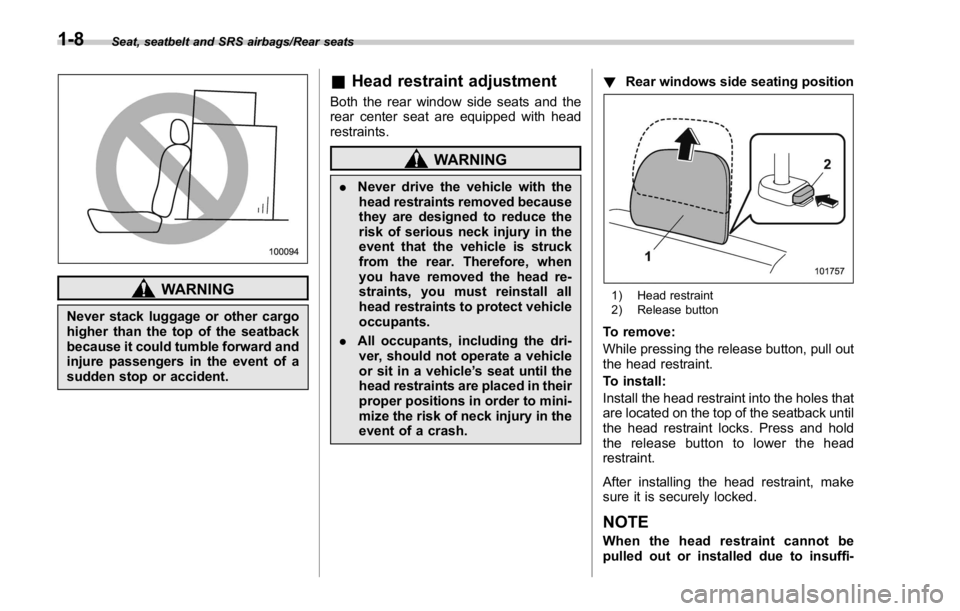
Seat, seatbelt and SRS airbags/Rear seats
WARNINGNever stack luggage or other cargo
higher than the top of the seatback
because it could tumble forward and
injure passengers in the event of a
sudden stop or accident. & Head restraint adjustment Both the rear window side seats and the
rear center seat are equipped with head
restraints.
WARNING. Never drive the vehicle with the
head restraints removed because
they are designed to reduce the
risk of serious neck injury in the
event that the vehicle is struck
from the rear. Therefore, when
you have removed the head re-
straints, you must reinstall all
head restraints to protect vehicle
occupants.
. All occupants, including the dri-
ver, should not operate a vehicle
or sit in a vehicle ’ s seat until the
head restraints are placed in their
proper positions in order to mini-
mize the risk of neck injury in the
event of a crash. ! Rear windows side seating position
1) Head restraint
2) Release button
To remove:
While pressing the release button, pull out
the head restraint.
To install:
Install the head restraint into the holes that
are located on the top of the seatback until
the head restraint locks. Press and hold
the release button to lower the head
restraint.
After installing the head restraint, make
sure it is securely locked.
NOTE
When the head restraint cannot be
pulled out or installed due to insuffi-1-8
Page 52 of 594
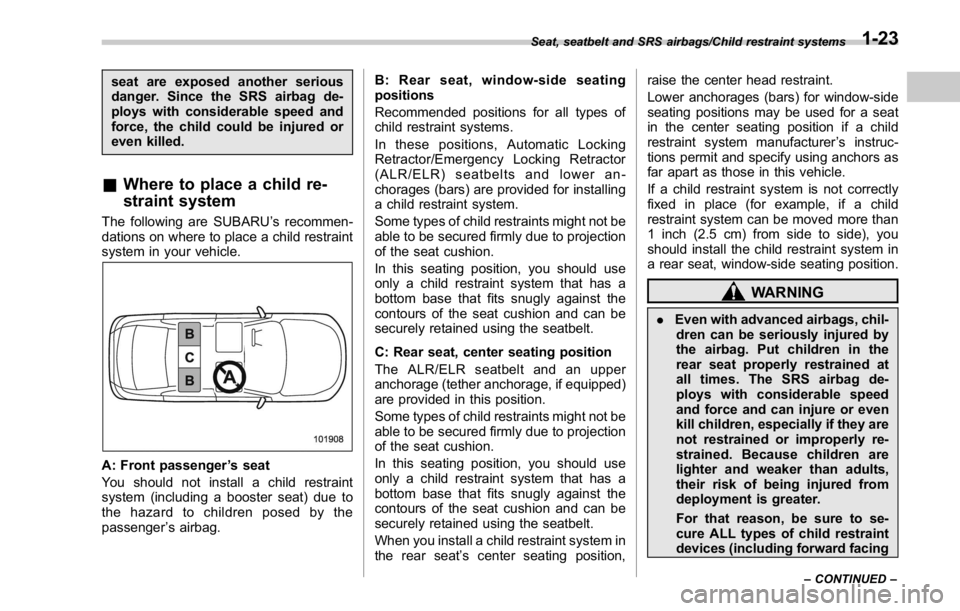
seat are exposed another serious
danger. Since the SRS airbag de-
ploys with considerable speed and
force, the child could be injured or
even killed.
& Where to place a child re-
straint system The following are SUBARU ’ s recommen-
dations on where to place a child restraint
system in your vehicle.
A: Front passenger ’ s seat
You should not install a child restraint
system (including a booster seat) due to
the hazard to children posed by the
passenger ’ s airbag. B: Rear seat, window-side seating
positions
Recommended positions for all types of
child restraint systems.
In these positions, Automatic Locking
Retractor/Emergency Locking Retractor
(ALR/ELR) seatbelts and lower an-
chorages (bars) are provided for installing
a child restraint system.
Some types of child restraints might not be
able to be secured firmly due to projection
of the seat cushion.
In this seating position, you should use
only a child restraint system that has a
bottom base that fits snugly against the
contours of the seat cushion and can be
securely retained using the seatbelt.
C: Rear seat, center seating position
The ALR/ELR seatbelt and an upper
anchorage (tether anchorage, if equipped)
are provided in this position.
Some types of child restraints might not be
able to be secured firmly due to projection
of the seat cushion.
In this seating position, you should use
only a child restraint system that has a
bottom base that fits snugly against the
contours of the seat cushion and can be
securely retained using the seatbelt.
When you install a child restraint system in
the rear seat ’ s center seating position, raise the center head restraint.
Lower anchorages (bars) for window-side
seating positions may be used for a seat
in the center seating position if a child
restraint system manufacturer ’ s instruc-
tions permit and specify using anchors as
far apart as those in this vehicle.
If a child restraint system is not correctly
fixed in place (for example, if a child
restraint system can be moved more than
1 inch (2.5 cm) from side to side), you
should install the child restraint system in
a rear seat, window-side seating position.
WARNING. Even with advanced airbags, chil-
dren can be seriously injured by
the airbag. Put children in the
rear seat properly restrained at
all times. The SRS airbag de-
ploys with considerable speed
and force and can injure or even
kill children, especially if they are
not restrained or improperly re-
strained. Because children are
lighter and weaker than adults,
their risk of being injured from
deployment is greater.
For that reason, be sure to se-
cure ALL types of child restraint
devices (including forward facingSeat, seatbelt and SRS airbags/Child restraint systems
– CONTINUED –1-23
Page 56 of 594
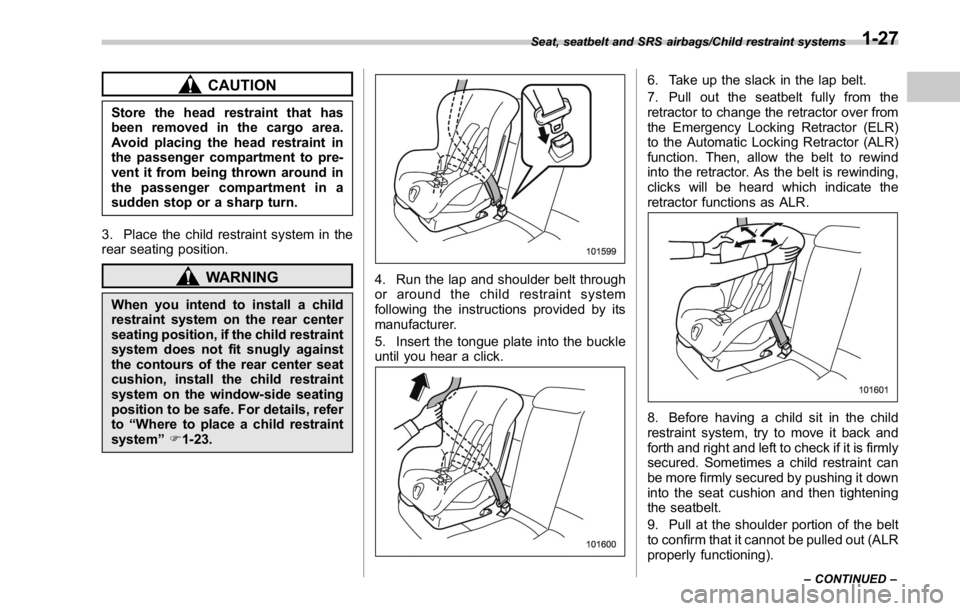
CAUTIONStore the head restraint that has
been removed in the cargo area.
Avoid placing the head restraint in
the passenger compartment to pre-
vent it from being thrown around in
the passenger compartment in a
sudden stop or a sharp turn.
3. Place the child restraint system in the
rear seating position.
WARNINGWhen you intend to install a child
restraint system on the rear center
seating position, if the child restraint
system does not fit snugly against
the contours of the rear center seat
cushion, install the child restraint
system on the window-side seating
position to be safe. For details, refer
to “ Where to place a child restraint
system ” F 1-23. 4. Run the lap and shoulder belt through
or around the child restraint system
following the instructions provided by its
manufacturer.
5. Insert the tongue plate into the buckle
until you hear a click. 6. Take up the slack in the lap belt.
7. Pull out the seatbelt fully from the
retractor to change the retractor over from
the Emergency Locking Retractor (ELR)
to the Automatic Locking Retractor (ALR)
function. Then, allow the belt to rewind
into the retractor. As the belt is rewinding,
clicks will be heard which indicate the
retractor functions as ALR.
8. Before having a child sit in the child
restraint system, try to move it back and
forth and right and left to check if it is firmly
secured. Sometimes a child restraint can
be more firmly secured by pushing it down
into the seat cushion and then tightening
the seatbelt.
9. Pull at the shoulder portion of the belt
to confirm that it cannot be pulled out (ALR
properly functioning).Seat, seatbelt and SRS airbags/Child restraint systems
– CONTINUED –1-27
Page 59 of 594
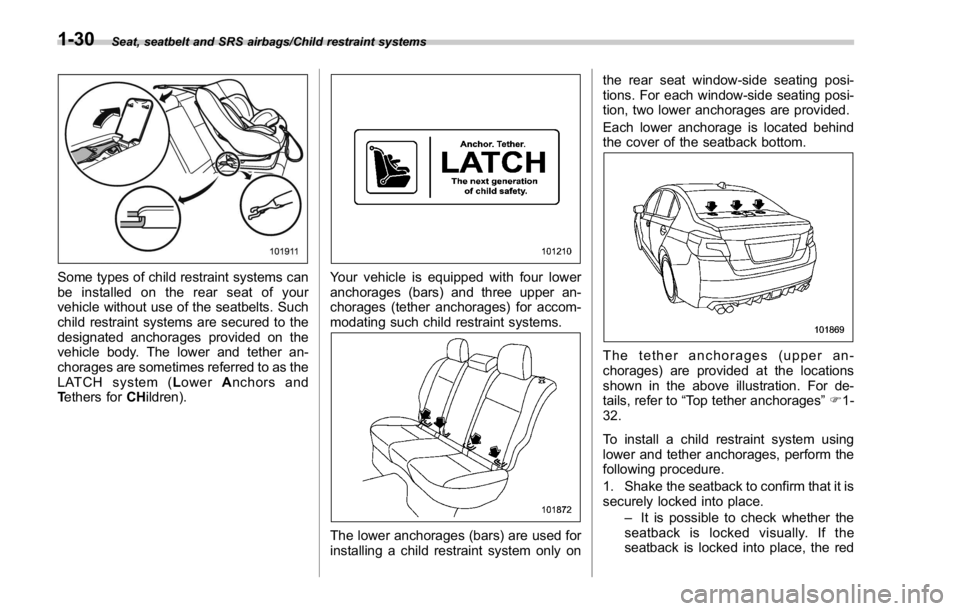
Seat, seatbelt and SRS airbags/Child restraint systems
Some types of child restraint systems can
be installed on the rear seat of your
vehicle without use of the seatbelts. Such
child restraint systems are secured to the
designated anchorages provided on the
vehicle body. The lower and tether an-
chorages are sometimes referred to as the
LATCH system ( L ower A nchors and
T ethers for CH ildren). Your vehicle is equipped with four lower
anchorages (bars) and three upper an-
chorages (tether anchorages) for accom-
modating such child restraint systems.
The lower anchorages (bars) are used for
installing a child restraint system only on the rear seat window-side seating posi-
tions. For each window-side seating posi-
tion, two lower anchorages are provided.
Each lower anchorage is located behind
the cover of the seatback bottom.
The tether anchorages (upper an-
chorages) are provided at the locations
shown in the above illustration. For de-
tails, refer to “ Top tether anchorages ” F 1-
32.
To install a child restraint system using
lower and tether anchorages, perform the
following procedure.
1. Shake the seatback to confirm that it is
securely locked into place.
– It is possible to check whether the
seatback is locked visually. If the
seatback is locked into place, the red1-30
Page 62 of 594
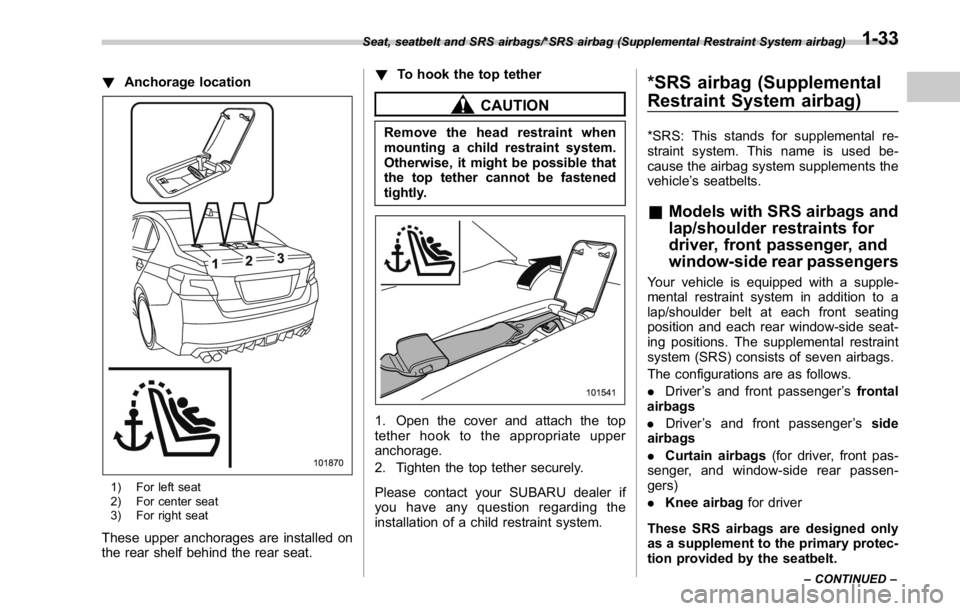
! Anchorage location
1) For left seat
2) For center seat
3) For right seat
These upper anchorages are installed on
the rear shelf behind the rear seat. ! To hook the top tether
CAUTIONRemove the head restraint when
mounting a child restraint system.
Otherwise, it might be possible that
the top tether cannot be fastened
tightly.
1. Open the cover and attach the top
tether hook to the appropriate upper
anchorage.
2. Tighten the top tether securely.
Please contact your SUBARU dealer if
you have any question regarding the
installation of a child restraint system. *SRS airbag (Supplemental
Restraint System airbag) *SRS: This stands for supplemental re-
straint system. This name is used be-
cause the airbag system supplements the
vehicle ’ s seatbelts.
& Models with SRS airbags and
lap/shoulder restraints for
driver, front passenger, and
window-side rear passengers Your vehicle is equipped with a supple-
mental restraint system in addition to a
lap/shoulder belt at each front seating
position and each rear window-side seat-
ing positions. The supplemental restraint
system (SRS) consists of seven airbags.
The configurations are as follows.
. Driver ’ s and front passenger ’ s frontal
airbags
. Driver ’ s and front passenger ’ s side
airbags
. Curtain airbags (for driver, front pas-
senger, and window-side rear passen-
gers)
. Knee airbag for driver
These SRS airbags are designed only
as a supplement to the primary protec-
tion provided by the seatbelt.Seat, seatbelt and SRS airbags/*SRS airbag (Supplemental Restraint System airbag)
– CONTINUED –1-33
Page 80 of 594

collision, the SRS curtain airbag on the
impacted side of the vehicle deploys
between the occupant and the side
window and supplements the seatbelt by
reducing the impact on the occupant ’ s
head.
In a frontal collision, SRS curtain airbags
on both sides of the vehicle deploy
between the occupant and the side
window and supplement the seatbelt by
reducing the impact to the occupant ’ s
head.
WARNINGThe SRS side airbag and SRS
curtain airbag are designed only to
be a supplement to the primary
protection provided by the seatbelt.
They do not do away with the need
to fasten seatbelts. It is also impor-
tant to wear your seatbelt to help
avoid injuries that can result when
an occupant is not seated in a
proper upright position. WARNING. Do not sit or lean unnecessarily
close to either front door. The
SRS side airbag is stored in both
front seat seatbacks next to the
door, and it provides protection
by deploying rapidly (faster than
the blink of an eye) in the event of
a side impact collision. However,
theforceofSRSsideairbag
deployment may cause injuries
if your head or other parts of the
body are too close to the SRS
side airbag.
. Since your vehicle is equipped
with SRS curtain airbags, do not
sit or lean unnecessarily close to the front or rear door on either
side. Also, do not put your head,
arms or hands out of the window.
The SRS curtain airbag on each
side of the cabin is stored in the
roof side (between the front pillar
and a point over the rear seat),
and it provides protection by
deploying rapidly (faster than
the blink of an eye) in the event
of a side impact. However, the
force of its deployment may
cause injuries if your head is
too close to it.
WARNING
Do not rest your arm on either front
door or its internal trim. It could beSeat, seatbelt and SRS airbags/*SRS airbag (Supplemental Restraint System airbag)
– CONTINUED –1-51
Page 81 of 594
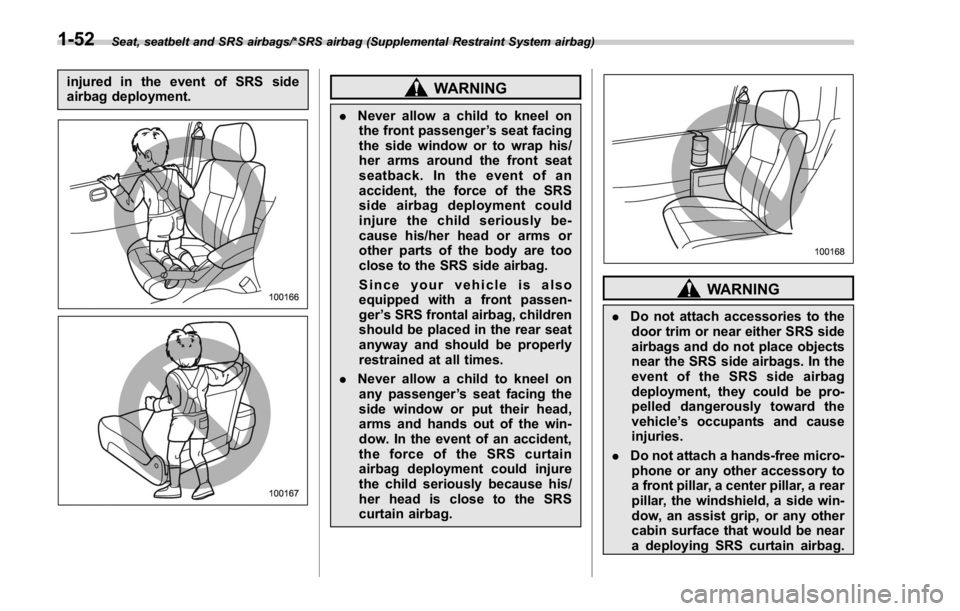
Seat, seatbelt and SRS airbags/*SRS airbag (Supplemental Restraint System airbag)
injured in the event of SRS side
airbag deployment.
WARNING. Never allow a child to kneel on
the front passenger ’ s seat facing
the side window or to wrap his/
her arms around the front seat
seatback. In the event of an
accident, the force of the SRS
side airbag deployment could
injure the child seriously be-
cause his/her head or arms or
other parts of the body are too
close to the SRS side airbag.
Since your vehicle is also
equipped with a front passen-
ger ’ s SRS frontal airbag, children
should be placed in the rear seat
anyway and should be properly
restrained at all times.
. Never allow a child to kneel on
any passenger ’ s seat facing the
side window or put their head,
arms and hands out of the win-
dow. In the event of an accident,
the force of the SRS curtain
airbag deployment could injure
the child seriously because his/
her head is close to the SRS
curtain airbag. WARNING. Do not attach accessories to the
door trim or near either SRS side
airbags and do not place objects
near the SRS side airbags. In the
event of the SRS side airbag
deployment, they could be pro-
pelled dangerously toward the
vehicle ’ s occupants and cause
injuries.
. Do not attach a hands-free micro-
phone or any other accessory to
a front pillar, a center pillar, a rear
pillar, the windshield, a side win-
dow, an assist grip, or any other
cabin surface that would be near
a deploying SRS curtain airbag.1-52